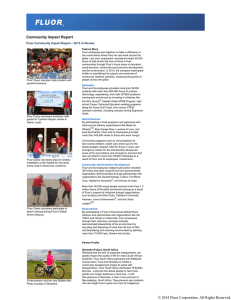Measuring Performance in a Commercial Enterprise
advertisement
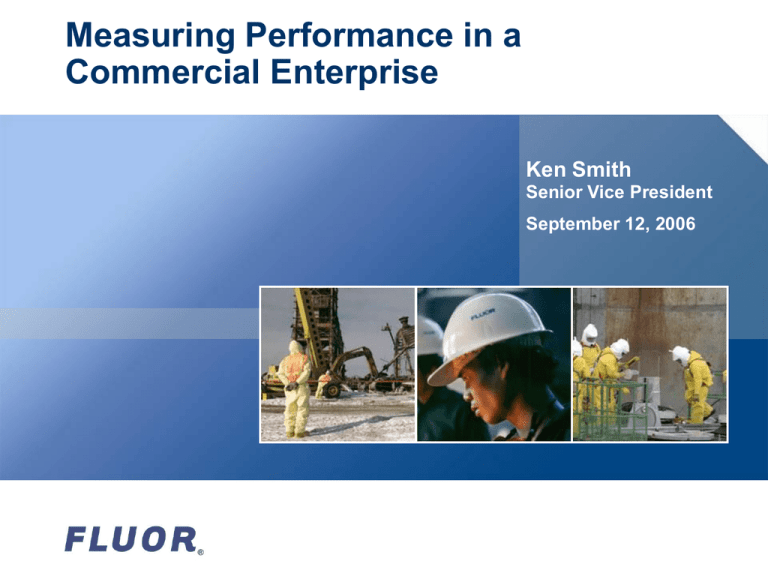
Measuring Performance in a Commercial Enterprise Ken Smith Senior Vice President September 12, 2006 Fluor Corporation’s Legacy Fluor is one of the world’s largest, publicly owned engineering, procurement, construction, and maintenance companies. Founded more than 100 years ago Executed more than 10,000 projects worldwide Consistently ranked among the “Top 3” on ENR magazine’s “Design-Build Firms” and “The Top 400 Contractors” lists One of the world’s safest contractors Maintains a global presence: - Asia, 55 years Africa, 41 years Australia, 37 years Europe, 59 years Middle East, 59 years South America, 61 years Corporate Headquarters – Irvine, Texas Fluor Industries and Clients Worldwide Projects Infrastructure Government Chemicals Government London Underground Ltd. Hanford Management Contract Kodak Fernald Environmental Restoration Xiamen, China Downstream Petrochemicals Phillips S Zorb Texas Mining EQUATE Project Kuwait City, Kuwait Copper Smelter Queensland, Australia Business Group Common Functions Safety performance and Zero IncidentsSM culture Operating System Requirements – Drives commonality across all operations globally Project management Engineering Financial metrics and performance measurement Human Resources – Global management focus Centralized corporate approach: – – – – – – – Strategic planning Business Risk Management Framework (BRMF) Legal Finance / cash management / SEC reporting Public relations / government relations Security / IR / ESH Board of Directors / stakeholders Safety Performance Operating in 60 countries worldwide; 40,000-employee diverse workforce (with language, educational and cultural differences) Managing and monitoring 270 million of safe work hours in 2005 Best in class performance – Management commitment to annual performance improvement Fluor’s culture drives – – – – Focus on precursors to prevent significant injuries/incidents Continuous improvement Rigorous reporting Incident investigation and lessons learned Senior management expectations are Zero Incidents and safety excellence Safety – Lost Workday Case Rate Safety – Recordable Incident Rate Commercial Background 25 years in the EPCM industry Experience includes three EPCM firms’ cultures to draw upon Understand the unique differences in Commercial vs. Government client organizations Recent 3-year President of Fluor’s Manufacturing & Life Sciences group Commercial Industry differentiators – – – – – – – Commercial industry specialization & market niches Global sales & execution platform Flexible procurement requirements Variety of commercial / contract structures Individual / flexible client drivers Business unit autonomy & internal decision making Flexible Industrial Relations / partnerships with Labor Personal Operating Philosophy Focus on safety Clear roles, responsibility, authority and accountability Customers want to know three things: – How smart? – How much? – How long? We owe our client to be the lowest cost producer for a given scope Cradle-to-Grave project execution – Comprehensive risk management – Baseline Centric approach Human capital management Financial performance “Bringing certainty to Technology Application, Cost and Schedule” Baseline CentricSM Approach COST MODEL • Basis of Estimate • Clarifications • Allowances • FOCUSSM • CDR PURCHASING • Scope Reviews • Buy Sheet Tracking • Bid Pkg. Cost Distribution SCHEDULING BASELINE • Quantities • Craft • Equipment / Material COST CONTROL • Changes • ROM Estimates GENERAL CONDITIONS • Staffing • Reimbursables Baseline Centric Tools Function – FOCUSsm process – Business Risk Management Framework Cost – – – – – Detail quantity-based control estimates Prologtm and MaterialManagersm for procurement FDCost and ProfiToolsm for cost control FDAS / SAP for accounting Cost Summary Report for financial performance Schedule – Primaveratm – EZTrak – MileMarker Baseline Centric Deliverables Establish “A line in the sand early” Accurate estimate – Detailed quantity takeoffs – Qualifications and clarifications – Allowances and exclusions FOCUSsm sessions Constructability reviews / alternative solutions Value engineering Manpower scheduling Business Risk Management Framework Snapshots during conceptual engineering; change management during detail design Baseline Centric Flowchart PROJECT MANAGEMENT / CONTROLS CONTRACTOR, VENDOR & SUPPLIER INVOICES • Base • Approved Change Orders • Proper Format • Lien Releases • • • • • • Check For Correct Format Check % Base Complete Check % Change Complete No Sub Tier Claims Approve For Processing Disapprove (3 Day Cycle) ACCOUNTS PAYABLE • Check Lien Waiver • Check Bonding / Insurance Validity • Check For Signed Contract & Changes • Check For Proper Authorization • Check For Proper Amounts - Contract • - C.O.’s • - Retention • • Check For Payment From Client • • Approve For Check Selection FINANCIAL Confirm Payment From Client Final Quality Check Resolve Conflict Release Payments Performance Measurement Approaches Safety – Monitor traditional safety trends – Application of Fluor’s safety alert system – Client feedback Client satisfaction – Percentage of repeat business – Extensive client review process Cradle-to-Grave project execution – Earned value management system – Independent project management review teams Human capital – Turnover / retention Financial performance – Margins: as sold vs. actual performance – Publicly traded company – stock price Closing Thoughts Challenge to provide commercial practices in the Government sector Project execution success is driven by upfront planning and establishing an accurate Baseline Managing people – We cannot lose sight of protecting the safety of our individual employees If we take care of clients, execute projects effectively, protect our employees, then we’ll achieve financial success
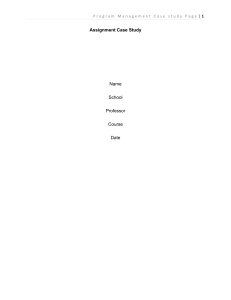


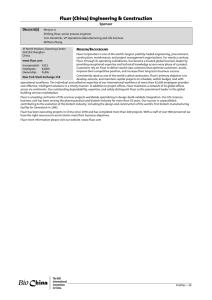
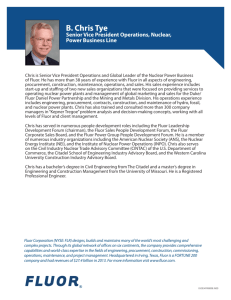



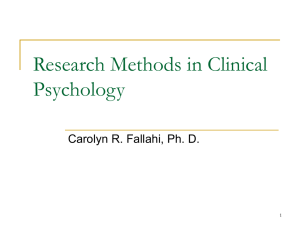

![Anti-BNIP3 antibody [ANa40] (Alexa Fluor® 647) ab196706](http://s2.studylib.net/store/data/012083394_1-2ff7db27c0d6912ecfc1f982c1a7d990-300x300.png)
